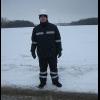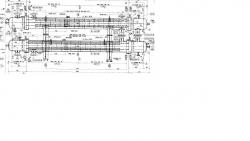|
|

Numbers Of Tube Passes Per Shell
#1

Posted 07 September 2012 - 06:10 AM
Please help with next issue:
Numbers of shell passes is 1
Numbers of shells in series is 2
Number of shells in parallel is 1
Tube passes per shell is 2
Am I right with this data? Please see attached file
Dmitry
#2

Posted 07 September 2012 - 02:40 PM
I may be wrong – mainly because at 75 years, my eyes aren’t what they used to be – but I believe what I can make out in your scanned General Arrangement drawing is two, identical, BEM stacked heat exchangers operating as one unit with each having:
- One pass per shell; and
- One tube pass per shell.
#3

Posted 07 September 2012 - 03:15 PM
You were correct except for the number of tube passes. Art caught this tube pass error correctly. They are one(1) tube pass heat exchangers.
#4

Posted 07 September 2012 - 07:38 PM
You usually have a view of the tubsheets and heads. Consult them to be sure. Both the responses above are from old guys, and they are not necessarily getting a complete picture either.
Bobby
#5

Posted 07 September 2012 - 08:42 PM
Es peligroso porque es viejo.
#6

Posted 08 September 2012 - 04:41 AM
Mr. Montemayor has already answered your question. Just an additional suggestion from my side. You can distinguish between even and odd tube passes by looking at the location of the channel side nozzles. If the nozzles are at opposite ends (as is the case in your drawing), it has to be odd no. of tube passes and hence 2 tube passes are not possible.
Regards
Dipankar
#7

Posted 09 September 2012 - 11:48 PM
Could you give a link or some document where I can find explanation how to define heat exchangers details.
Dmitry
#8

Posted 10 September 2012 - 09:24 AM
Here are some literature sources that give detailed mechanical information on shell-and tube heat exchangers:
Serth,R.W., Process Heat Transfer
Cao, E., Heat Transfer in Process Engineering
Heat Exchanger Design Handbook
TEMA (shows nomenclature)
#9

Posted 10 September 2012 - 11:08 PM
Dmitry,
Here are some literature sources that give detailed mechanical information on shell-and tube heat exchangers:
Serth,R.W., Process Heat Transfer
Cao, E., Heat Transfer in Process Engineering
Heat Exchanger Design Handbook
TEMA (shows nomenclature)
Than you for help, I wil try to find these books
Dmitry
Similar Topics
Rotated Triangular Tube Layout Vs Triangular Tube LayoutStarted by Guest_Heat Transfer Novice_* , 28 Sep 2024 |
|

|
||
Supercritical Fluid Flowrate - He Tube RuptureStarted by Guest_flarewolf_* , 07 Apr 2025 |
|

|
||
Tube Rupture ReliefStarted by Guest_felderosfelder101021_* , 16 Jan 2025 |
|

|
||
Maximum Mass Flow In A Shell & Tube Heat ExchangerStarted by Guest_DonStalke_* , 22 Sep 2024 |
|

|
||
How To Use Shell Thermia B Oil In Hysys/ AspenStarted by Guest_sportybk_* , 24 Jul 2024 |
|

|

 FB
FB











